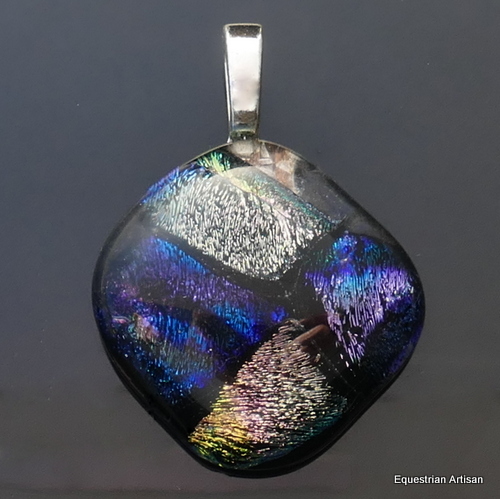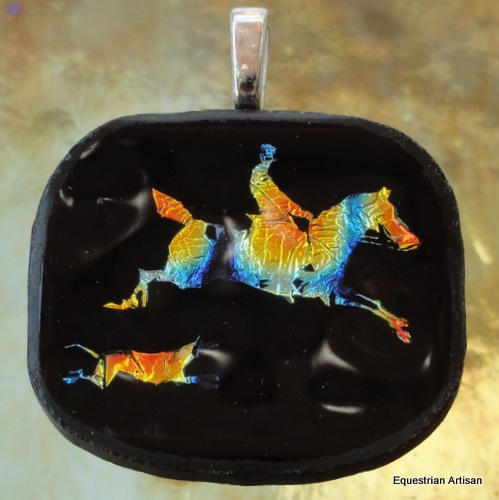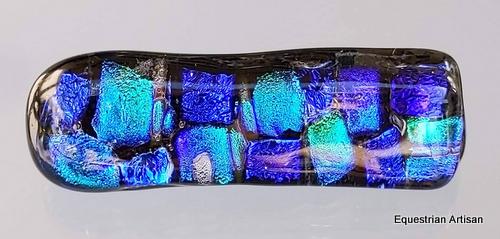All You Ever Wanted to Know About Dichroic Glass!

Dichroic glass is one of the most exciting materials I use in my studio. Its super-vivid colors are bright and reflective, and its hues shift as the light changes. These mesmerizIng effects elevate pieces that might otherwise be ordinary and makes them extraordinary.
So what exactly is dichroic glass and what makes it so special? Let’s explore its unique qualities, see how it’s made, and learn about the different styles of dichroic glass that are available to artists.
The mesmerizing interplay of color is evident in this dichroic glass pendant, at left.
What is dichroic glass and what’s all the fuss about it?
The science behind the glow: reflected vs. transmitted light
The secret behind all these captivating effects is how dichroic glass interacts with light.
Reflected Light: This is the light that bounces off the surface of dichroic glass. The colors you see as reflected light are vibrant and bold and shift depending on your viewing angle. This is what gives dichroic glass its signature shimmering and iridescent appearance.
Transmitted Light: When light passes through the glass from behind it reveals a completely different color than what you see when it reflects. For example, a piece of dichroic glass might reflect a brilliant blue, but if you hold it up to the light, you might see a warm orange or pink transmitted through the glass. This duality in color is what makes dichroic glass so mesmerizing and versatile for both jewelry and decor.
How is dichroic glass made?
Creating dichroic glass is a highly technical process. Layers of metallic oxides (including titanium, aluminum, chromium, zirconium, and magnesium oxides) are vaporized in a vacuum chamber where they condense on either clear or black glass in micro-thin layers. This process is called thin-film deposition, and it’s repeated up to 30 times to achieve the desired reflective and transmitted color effects. The metal oxides act as interference layers, selectively reflecting certain wavelengths of light while allowing others to pass through, resulting in the color-changing effect depending on the viewing angle. The specific colors produced depend on the combination and thickness of the metal oxide layers applied. The coating are fused to the glass at high temperature and create a permanent, vibrant surface.
The differences between clear & black substrates
Dichroic glass is manufactured on either clear or black glass, referred to as the substrate, and each color brings its own distinct visual qualities:

Dichroic on Clear Glass: When dichroic coatings are applied to clear glass, light can pass through and we see transmitted light as well as reflected light. This results in a subtle, translucent appearance. When layered over other colors or textures, it can create a multi-dimensional, glowing effect that changes as you look at it.
Dichroic on Black Glass: On black glass we see only the reflected light, which appears bolder and more intense. Dichroic glass on black substrate is perfect for pieces where you want the colors to be super-vivid and eye-catching.
The multi-colored dichroic coating on the black substrate at left was etched off to expose all the areas that you see as black in the finished pendant.
Too many choices?! Color patterns, textures, & more!
As if the color and substrate choices aren’t already wide enough, dichroic glass is manufactured on different kinds of textured glass and in a large assortment of color patterns. It is also made in solid colors as well a patterns. Patterns include everything from stripes and dots, to more freeform designs with names like, “Tie-Dye,” “Spatter,” and “Balloons.” These designs can add visual interest and complexity to an otherwise simple piece. Textures, too, create a different and dynamic feeling when used in jewelry and decor items. Dichroic coatings are even sold as powdered pigment that can be mixed with medium and used as paint! The brilliant hues and color-shifting properties of dichroic glass, combined with all the different textures and color patterns available, makes each piece in which it is used a dynamic, and absolutely one-of-a-kind work of art.
At right, patterned dichroic glass waiting to be used in a project.

Why I use dichroic glass in my jewelry & home accents
If you can’t tell by now, I love working with dichroic glass because it produces unique, eye-catching pieces that stand out in any setting. You’ll see it throughout this website, in everything from pendants, brooches, and earrings that shimmer with every movement, to fused glass dishes and art panels that catch and reflect the light in your home. Every item is handcrafted in my studio, and no two pieces are ever exactly alike.
At the end of the day, dichroic glass is about more than just color—it’s about movement, light, and transformation. Enjoy exploring our collections today and discover the perfect piece to add elegance and mystery to your life.
This dichroic glass dish has squares of clear glass spaced evenly over its surface. It shows the difference between the finished look of capped dichroic glass (i.e. dichroic glass fused with clear glass on top of it) vs. uncapped dichro, while still showing the distinctive pattern and range of colors that the manufacturer’s of this piece of glass produced.
The small shards of dichroic glass used in this mosaic brooch are a great example of the intense glow dichroic glass is known for.


